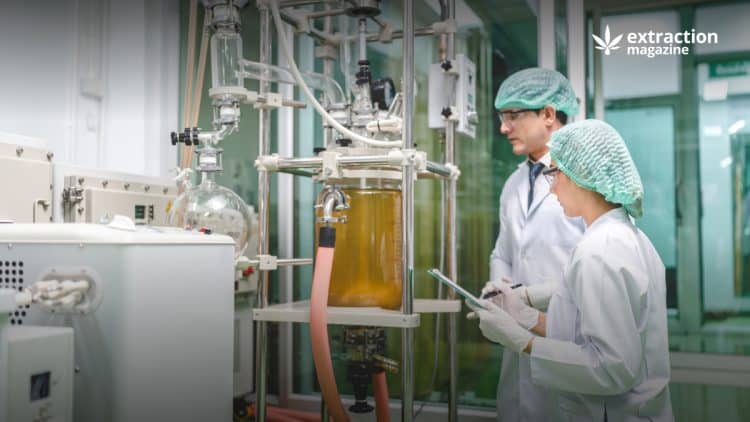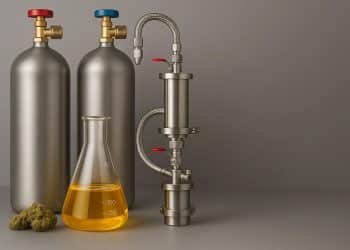The natural world is almost never simple. Finding something that is a pure compound almost never exists on its own. However, in the world of chemistry, it is possible to isolate and concentrate chemical compounds. In fact, it is even possible to take complex mixtures found in the natural world and simplify them into their purest constituents. This is possible through a process called distillation. Distillation is essentially the isolation and separation of individual compounds from a complex mixture based on their boiling point, through continual evaporation and condensation. One of the most common forms is called short path distillation, which has clear advantages for both the user and finished product. [1]
How does Short Path Distillation Work?
Short path distillation gets its name from the short distance that the solution has to travel. Depending on the precise configuration of equipment, this distance is often only a few centimeters, meaning it only requires a small amount of lab space to be performed. To start, the solution of extraction material is added to a flask. This flask serves as a feeding vessel to the distillation system.
Slowly, the temperature is raised, which allows for evaporation to occur. To lower the amount of heat necessary to achieve vaporization, short path distillation is performed putting the system under vacuum. [2] Within the vacuum, ambient pressure is raised, utilizing aspects of Charles’ Law to lower the boiling point of the material to be distilled. [3] As the extraction material vaporizes, it rises into a fractionalization tube, where it mixes with additional vapors like water or air to aid in the cooling and condensation of the material. [4]
This condensed material is siphoned off into a separate flask where it transitions from a vapor back to a liquid. In order to ensure a purity of the distilled material, the additional vapors used to cool the extraction material are separated out of the vacuum. This creates two separate flasks, one with a concentrated extract and the other with the distilled and recondensed products that can both be unwanted byproducts or precious pure compounds of interest. To ensure the highest purity and the maximum yield, this process of short path distillation can be performed multiple times.
Advantages of Short Path Distillation
There are several advantages to short path distillation compared to other distillation methods. As the name implies, the short path means that the extracted material only has to travel a few centimeters. [5] This means that the equipment needed only takes up a small amount of space, and can be performed with basic flasks, tubes and heating sources. The set-up, while simplified and small, allows for continuous feeding of extraction material to the distillation system. [6] This means that the process can be automated and can shorten the time needed to isolate the materials.
In addition to the simplified arrangement of equipment, the vacuum provides some advantages as well. First, by reducing the pressure in the equipment, the boiling and vaporization point of the extraction material is lower than it would be at a standard external pressure. This means that less heat is needed to start the distillation, which can lower costs over an extended time frame. There is a second advantage to using less heat, short path distillation works exceptionally well with products that are sensitive to heat. [7]
On top of the lower heat exposure, short path distillation’s vacuum also leaves both purified extraction materials and purified solvents. [8] This allows for various solvents to be recycled, cutting costs even further. Finally, in addition to the ease of use, continuous feeding, and benefits from the vacuum, short path distillation creates high yields of final products with exceptional levels of purity. [9] This advantage is twofold: first, whatever the desired extract is has fewer flaws and contaminants, making it more appealing for any further uses. And second, there are less harmful byproducts in the leftover material, because any other additional materials within the initial solution can either be isolated themselves.
Common Applications of Short Path Distillation
Short path distillation is one of the most commonly used procedures in the extraction process. This is due to its various advantages, but its ubiquity breeds familiarity. In the food industry, this type of distillation is most commonly used with various oils. This may come in the form of concentrated essential oils or deodorizing fats and oils from animal products. [10][11]
Additionally, alcoholic beverages rely on distillation to remove the methanol from the initial plant mash, but also to infuse the beverage with plant aromas in steam current. [12] In a similar vein, the entire perfume industry uses short path distillation. [13] Starting with a complex mix of aromas, the final fragrances are a product of the concentration and purification of the essential ingredients into a small bottle.
Another industry that prioritizes taste and smell is the cannabis industry. [14] Using short path distillation allows cannabis extracts to preserve complex terpene profiles while avoiding any loss of flavors due to overexposure to heat. Finally, the lower usage costs make it the preferred distillation method for several heavy industries. In petroleum refinement, hydrocarbon chains need to be separated from crude oil to convert to valuable petroleum. [15] As previously stated, volatile products that are sensitive to heat utilize the increase in pressure to lower the amount of heat needed. The same principle also applies to the related petrochemical industry. Hydrocarbon chains also need to be removed to create polyethylene and polyurethane. [15][16] Because these products are also sensitive to high temperatures, short path distillation can be used effectively with minimal risk.
References:
- Oterhals, Åge, Bjørn Kvamme, and Marc HG Berntssen. “Modeling of a short-path distillation process to remove persistent organic pollutants in fish oil based on process parameters and quantitative structure properties relationships.” Chemosphere 80.2 (2010): 83-92.
- Bethge, Daniel. “Short path and molecular distillation.” Vacuum Technology in the Chemical Industry (2014): 281-294.
- Adcock, Louis H. “The egg in the bottle revisited: Air pressure and Amontons’ law (Charles’ Law).” Journal of chemical education 75.12 (1998): 1567.
- Hu, Hui, et al. “Simulation of vapor flows in short path distillation.” Computers & Chemical Engineering 49 (2013): 127-135.
- Pietsch, Arne, and Philip Jaeger. “Concentration of squalene from shark liver oil by short‐path distillation.” European journal of lipid science and technology 109.11 (2007): 1077-1082.
- Galy, Nicolas, et al. “Glycerol oligomerization in continuous flow reactor.” Journal of Industrial and Engineering Chemistry 51 (2017): 312-318.
- Zou, Long, and Casimir C. Akoh. “Identification of tocopherols, tocotrienols, and their fatty acid esters in residues and distillates of structured lipids purified by short-path distillation.” Journal of agricultural and food chemistry 61.1 (2013): 238-246.
- Redmann, Ines, et al. “Fructose mono-and polycaprylate purification by molecular distillation.” Biotechnology techniques 9.2 (1995): 123-126.
- Abd Maurad, Zulina, et al. “Combined esterification and short‐path distillation for high‐purity Pentaerythritol Ester from palm kernel for biolubricants.” Journal of the American Oil Chemists’ Society 95.11 (2018): 1421-1429.
- Tovar, Laura P., et al. “Short-Path-Distillation process of lemongrass essential oil: Physicochemical characterization and assessment quality of the distillate and the residue products.” Industrial & engineering chemistry research 50.13 (2011): 8185-8194.
- Xu, Xuebing, et al. “Purification and deodorization of structured lipids by short path distillation.” european Journal of Lipid science and technology 104.11 (2002): 745-755.
- Bieber, Lothar W., and Maria CF De Araújo. “Short and efficient synthesis of optically active N-tosyl aziridines from 2-amino alcohols.” Molecules 7.12 (2002): 902-906.
- Lovchik, Martin A., Chi-Lam Tse, and Simon Ellwood. “Process Research and Scale-Up Synthesis of 3-(4-Isobutyl-2-methylphenyl) propanal, a Safe and Uniquely Performing Perfumery Ingredient.” Organic Process Research & Development 24.12 (2020): 2906-2914.
- Teräsvalli, Heini. “Extraction and purification of cannabidiol.” (2020).
- Lee, Frank Sen-Chun. “Characterization of Petroleum Resid Components Fractionated by High Vacuum Short Path Distillation and Gel Permeation Chromatography.” PREPRINTS OF PAPERS-AMERICAN CHEMICAL SOCIETY DIVISION FUEL CHEMISTRY 40 (1995): 497-497.
- Chongcharoenyanon, Busarin, et al. “Extraction of volatile flavour compounds from butter oil in a low‐density polyethylene membrane pouch.” Flavour and fragrance journal 27.5 (2012): 367-371.
- Heijkants, R. G. J. C., et al. “Design, synthesis and properties of a degradable polyurethane scaffold for meniscus regeneration.” Journal of Materials Science: Materials in Medicine 15 (2004): 423-427.












